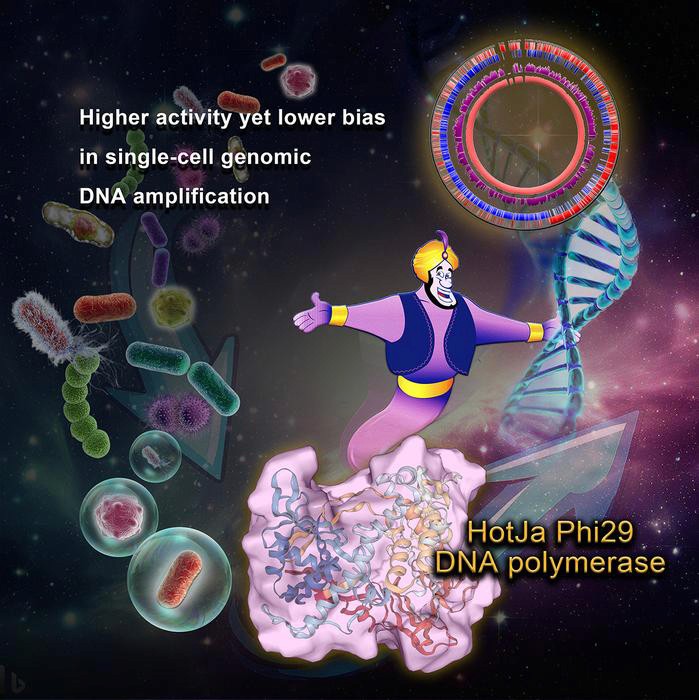Single-Cell Sequencing Gets a Serious Boost from Engineered Polymerase
A groundbreaking method to reduce bias in the gene amplification stage of single bacterial cell genome sequencing has been developed that could revolutionize the field of single-cell research
Jul 25, 2023
Illustration by Jill George using images from the National Human Genome Research Institute & the National Institute of Allergy and Infectious Diseases
In a groundbreaking development that could revolutionize single-cell research, scientists at the Single-Cell Center, Qingdao Institute of Bioenergy and Bioprocess Technology (QIBEBT) of the Chinese Academy of Sciences (CAS), have devised a method to significantly reduce bias in the gene amplification stage of single bacterial cell genome sequencing. This advancement, detailed in a study published recently in Frontiers in Bioengineering and Biotechnology, could open up new avenues in the exploration of cellular relationships and lineage tracing.

Traditional gene sequencing methods typically involve millions of cells, a process that often obscures the unique characteristics of individual cells. This presents a particular challenge in bacterial research, given the minuscule size and DNA content of bacterial cells compared to their human or animal counterparts.
Gene amplification, a process akin to "molecular photocopying," is a crucial step in gene or whole genome sequencing, as it generates millions or even billions of DNA segment copies. While this process is generally unproblematic for bulk gene sequencing, it can introduce significant bias in bacterial single-cell DNA amplification, particularly in whole genomes, where the available DNA for copying is extremely limited.
"Reducing amplification bias has been something of a holy grail for single-cell genome amplification researchers," said ZHANG Jia, a biotechnologist with QIBEBT and lead author of the paper. "And we think we've now found a way to tackle this problem."
The team's solution is a process they've dubbed Improved Single-cell Genome Amplification (iSGA). This method involves both protein and process engineering to enhance the amplification ability of the phi29 DNA polymerase, a commonly used enzyme in single-cell whole genome amplification that has been plagued by issues of low genome coverage and efficiency.
"The iSGA phi29 DNA polymerase we developed is more than twice as efficient and robust than the conventional phi29 DNA polymerase," said ZHANG Jia. "It's also almost eleven times cheaper than the main commonly available commercial version."
The researchers achieved this by engineering the polymerase to boost its amplification ability. They used a method called compartmentalized self-replication (CSR) to evolve the phi29 DNA polymerase, modifying its structure to enhance its activity, specificity, and stability. "The newly developed DNA polymerase, what we called HotJa Phi29 DNA polymerase, shows significantly better genome coverage (99.75%) at a higher temperature (40℃) compared to existing commercial polymerases," said one senior author Prof. XU Jian from Single-Cell Center of QIBEBT.
In addition to modifying the polymerase, the team also optimized the amplification reaction conditions and adjusted the amplification buffer to improve the stability and activity of the phi29 DNA polymerase. They also developed a more efficient decontamination method to reduce contamination during the amplification process.
The team is now focused on optimizing their iSGA method and HotJa Phi29 DNA polymerase across various applications and sample types and further reducing costs. They have developed a series of instruments, including RACS-Seq, FlowRACS, and EasySort, for the functional sorting of microbial single-cells. Their ultimate goal is to enable microbiologists to sort and sequence any individual microbial cells on Earth without worrying about data quality or reagent cost.


















